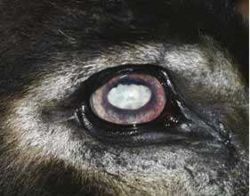Cataracts - Donkey
| This article has been peer reviewed but is awaiting expert review. If you would like to help with this, please see more information about expert reviewing. |
Introduction

A high proportion of The Donkey Sanctuary’s herd is elderly and so acquired, diffuse cataracts are very common. These are easily diagnosed.
Clinical Signs
- The lens is obviously opaque and the pupil fully dilated in severe cases
- There is reduced vision, especially in dim light
- Lack of a pupillary light response (PLR) indicates an advanced condition
- They can be unilateral or bilateral
Diagnosis
Pupillary dilation should be achieved prior to ophthalmoscopy to check the extent of the cataract, to rule out lens luxation and to check the fundus for recurrent uveitis, which will eventually cause cataracts. As most cases are secondary to recurrent uveitis, posterior synechiae develop due to the inflammatory response.
Nuclear sclerosis can be mistaken for cataracts. This is a normal ageing response as the lens hardens and takes on a ‘pearl-like’ appearance. However, the fundus is still visible through this.
Treatment
Surgery' to remove the lens is useful in cases of congenital cataracts. The optimal age for surgery is during the first few months. If recurrent uveitis has occurred then the success rates are lower.
References
- Grove, V. (2008) Conditions of the eye In Svendsen, E.D., Duncan, J. and Hadrill, D. (2008) The Professional Handbook of the Donkey, 4th edition, Whittet Books, Chapter 11
|
|
This section was sponsored and content provided by THE DONKEY SANCTUARY |
|---|